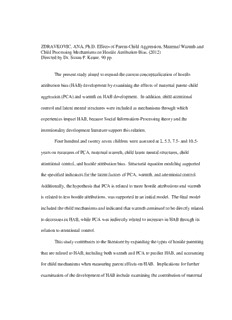
Effects of parent-child aggression, maternal warmth and child processing mechanisms on hostile ... PDF
Preview Effects of parent-child aggression, maternal warmth and child processing mechanisms on hostile ...
ZDRAVKOVIC, ANA, Ph.D. Effects of Parent-Child Aggression, Maternal Warmth and Child Processing Mechanisms on Hostile Attribution Bias. (2012) Directed by Dr. Susan P. Keane. 90 pp. The present study aimed to expand the current conceptualization of hostile attribution bias (HAB) development by examining the effects of maternal parent-child aggression (PCA) and warmth on HAB development. In addition, child attentional control and latent mental structures were included as mechanisms through which experiences impact HAB, because Social Information-Processing theory and the intentionality development literature support this relation. Four hundred and twenty seven children were assessed at 2, 5.5, 7.5- and 10.5- years on measures of PCA, maternal warmth, child latent mental structures, child attentional control, and hostile attribution bias. Structural equation modeling supported the specified indicators for the latent factors of PCA, warmth, and attentional control. Additionally, the hypothesis that PCA is related to more hostile attributions and warmth is related to less hostile attributions, was supported in an initial model. The final model included the child mechanisms and indicated that warmth continued to be directly related to decreases in HAB, while PCA was indirectly related to increases in HAB through its relation to attentional control. This study contributes to the literature by expanding the types of hostile parenting that are related to HAB, including both warmth and PCA to predict HAB, and accounting for child mechanisms when measuring parent effects on HAB. Implications for further examination of the development of HAB include examining the contribution of maternal HAB and child emotions, as well as determining the applicability of this research to preventative interventions. EFFECTS OF PARENT-CHILD AGGRESSION, MATERNAL WARMTH AND CHILD PROCESSING MECHANISMS ON HOSTILE ATTRIBUTION BIAS by Ana Zdravkovic A Dissertation Submitted to the Faculty of The Graduate School at The University of North Carolina at Greensboro in Partial Fulfillment of the Requirements for the Degree Doctor of Philosophy Greensboro 2012 Approved by ____________________________ Committee Chair To Jon Mason for his indescribable support, my mother for reading through text she does not understand, the rest of my family for keeping faith, and my fellow graduate students for holding each other together. ii APPROVAL PAGE This dissertation has been approved by the following committee of the Faculty of the Graduate School at The University of North Carolina at Greensboro. Committee Chair ______________________________ Susan P. Keane Committee Members ______________________________ Christina Rodriguez ______________________________ Gabriela Stein ______________________________ Janet Boseovski ____________________________ Date of Acceptance by Committee ___________________________ Date of Final Oral Examination iii ACKNOWLEDGEMENTS Support for the RIGHT Track project was provided by a grant from NIMH awarded to Dr. Susan Calkins. Dr. Scott Richter provided statistical consultation for this study. Additionally, many thanks to the members of the dissertation committee, Dr. Janet Boseovski, Dr. Christina Rodriguez, Dr. Gabriela Stein, and the committee chair, Dr. Susan Keane. iv TABLE OF CONTENTS Page LIST OF TABLES……………………………………………………………………... vi LIST OF FIGURES……………………………………………………………………. vii CHAPTER I. INTRODUCTION………………………………………………………….. 1 Developing the Ability to Infer Attributions of Intent…………………. 4 Latent Mental Structures Impacting Intent Attributions……………….. 8 On-Line Processing Impacting Intent Attributions…………………….. 10 HAB Stabilization……………………………………………………… 13 Parent Factors Contributing to HAB…………………………………… 15 Current Study…………………………………………………………... 22 II. METHOD………………………………………………………………….. 25 Participants…………………………………………………………….. 25 Measures……………………………………………………………….. 27 III. RESULTS………………………………………………………………….. 37 Data Analytic Strategy…………………………………………………. 37 Preliminary Analyses…………………………………………………... 40 Measurement Model…………………………………………………… 42 Structural Models………………………………………………………. 43 IV. DISCUSSION……………………………………………………………… 46 Limitations……………………………………………………………... 50 Future Directions………………………………………………………. 56 REFERENCES………………………………………………………………………… 59 APPENDIX A. TABLES AND FIGURES …………………………………………… 78 APPENDIX B. WHY KIDS DO THINGS 10YR…………………………………….. 89 v LIST OF TABLES Page Table 1. Descriptive Statistics ………………………………………………………… 78 Table 2. Correlation Coefficients ……………………………………………………... 79 Table 3. Model Fit Statistics …………………………………………………………... 80 Table 4. Measurement Model Results ………………………………………………… 81 Table 5. Initial Structural Model Results ……………………………………………… 82 Table 6. Structural Model Results …………………………………………………….. 83 Table 7. Standardized Direct and Indirect Effects on HAB Calculated from Structural Model .…………………………………………………….. 84 vi LIST OF FIGURES Page Figure 1. Conceptual model …………………………………………………………... 85 Figure 2. Measurement model assessing latent factors with standardized paths reported .………………………………………………………..… 86 Figure 3. Structural model assessing direct effects with standardized paths reported ……………………………………………………………. 87 Figure 4. Structural model assessing direct and indirect effects with standardized paths reported .……………………………………………. 88 vii CHAPTER I INTRODUCTION Hostile Attribution Bias (HAB) is a tendency to attribute hostile intent in a range of situations. There are times when inferring hostile intent is correct, such as when a person is purposefully harmed. However, individuals with a hostile attribution bias infer hostile intent from not only overtly hostile actions, but also from ambiguous actions (Crick & Dodge, 1994; Dodge, 1980; Dodge & Coie, 1987). The term HAB was defined by Nasby and colleagues (Nasby, Hayden, & DePaulo, 1980) following a study that examined incarcerated youth ages 10 to 16. They found that a subgroup of these youth were more likely to assign a hostile plot to emotionally-laden photographs, than other youth of the same age. These children did not show a keen ability to identify hostile situations compared to other institutionalized boys; instead, they exhibited a pattern of over-attributing hostile intent even if the cues provided were ambiguous or benign (Nasby et al., 1980). Research conducted on a large sample by Dodge and colleagues (1995) indicates that as many as 46% of children between first and fourth grades over- attribute hostile intent. Clinically aggressive children and juvenile offenders have significantly higher levels of HAB than the normative population (Bailey, et al., 2007; Williams et al., 2003). Since studies tend to view HAB as a continuous construct, rates of HAB in these specific populations are not available. In a more general sense, HAB can function as a worldview, such that children with HAB assume that most people 1
Description: